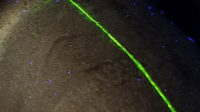Speaking of Quality | Sheri Dorman
Visual Inspection Remains Most Popular Flaw Detection Method
Visual inspection is the most popular method of determining what defect, or flaw, is acceptable or not.

Image Source: MachineHeadz/iStock/Getty Images Plus via Getty Images
Sight. This basic human sense affects our quality of life, and it can be enhanced or diminished with just a glance. Have you ever had a BBQ stain on a white T-shirt? When people walk by, they look at the stain. What about selecting fruits and vegetables at the market? We look for unbruised apples or bananas, berries that are not over ripe and fuzzy (yuck) or lettuce that is not wilted. Aren’t we thankful for pre-flight inspections taken before our plane leaves the gate?
These common, everyday scenarios are immediately accepted or dismissed based on a standard. Same is true in manufacturing. A wide range of industries view visual appearance as an important aspect of quality. The art of decision-making based on visual appearance with the naked eye, or aided by vision systems, is key to success. The eye needs to be “trained” to see the defect. However, subjectivity, or bias, needs to be greatly reduced or eliminated in order to clearly establish what is a pass/fail condition and not what is thought to be.
Visual appearance criteria must be established as soon as possible in the project. These may be a major hurdle that affects the manufacturability of the product or cost in doing business.
By understanding the application or knowing where or how it is seen by others are major contributors to consider. It could be as easy as a checklist, a yes/no, pass/fail record. Is the light on? Is the fan off? Other visual inspections may be more difficult.
Visual defect criteria can be classified as:
- Surface defects such as scratches, cracks, dents, FOD (Foreign Object Debris like excess paint, flaking).
- Features that are missing, present, or abnormalities.
- Variations in color, hue, see through and other visible imperfections that affect the appearance or performance.
The customer has specific requirements. They provide requirements by engineering drawings with notations or references to the customer’s internal control documents, and other standards (ASTM, SAE, etc). Especially in automotive, medical, aerospace, and consumer goods, visual appearance criteria is of great importance. Customers may not say what limits are acceptable, because they may not know themselves. This puts the supplier in a position to draw this out so it can be established upfront in order to discern what is expected, but not stated.
Visual appearance criteria must be established as soon as possible in the project.
There may be process indicators. Every process has some type of trigger and performance outputs that can be associated as “part of the process.” Whether it is acceptable, or to what degree it is acceptable, will be an important conversation. For example, plated parts have some water marks left on the part. They can’t be wiped off. Will this affect the customer’s intent? Is there a limit that can be established?
The last consideration is probably the most underestimated criteria. Aesthetics. This can be very challenging to define. For a consumer good like a stainless-steel grill or automobile, size and depth of an imperfection can determine if the product will be bought or if the seller will repair it. Is the defect on the hood or is it in the glove box? No process or product will be 100% perfect, but how close is close enough? Identifying surface classifications, where and how much of a flaw is deemed acceptable.
For example, surface classification “A” is an area of top appearance. The customer will definitely see it. Surface classification “B” is an area where the customer may or may not see it. Surface classification “C” is an area where the customer cannot see it. What defects, if any, are allowed on each surface? See the chart below that describes what is acceptable and not acceptable.
Why is this important to know? How much time, resources and cost will be spent on inspecting a SC-A versus a SC-C? We can focus on what the customer wants and distribute the cost in doing business. Let’s compare this chart to “look for scratches on the part.” Which inspection would you feel more confident?
Mastering inspection with a trained eye is a unique skill. The ASQ Inspection Division sponsors two certifications: CQI (Certified Quality Inspector) and CQT (Certified Quality Technician). These certifications empower you to understand the skills and techniques of inspection.
Looking for a reprint of this article?
From high-res PDFs to custom plaques, order your copy today!





